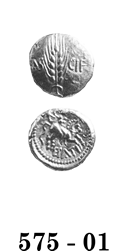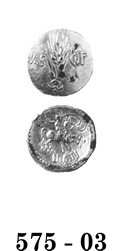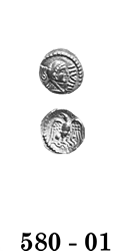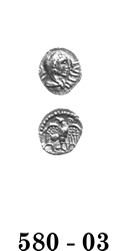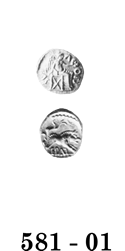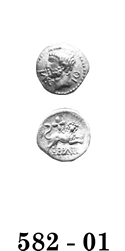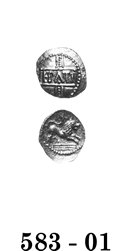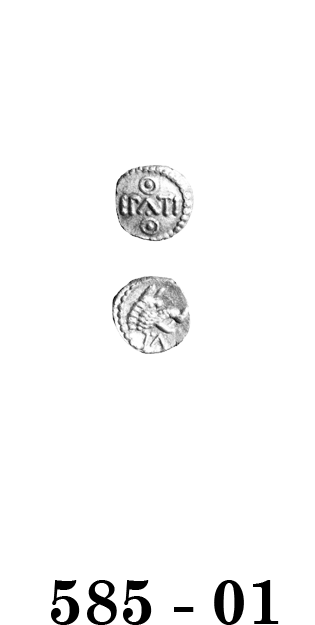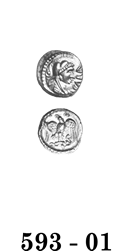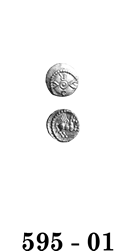
Celtic Coinage of Britain
third edition
Click on coin to see hidden information
The Coinage of Epaticcus
The coins of Epaticcus appear shortly before the Claudian invasion in the northern part of Atrebatic/Regnan/Belgic territory. Epaticcus evidently was a Trinovantian/Catuvellaunian sympathizer, or perhaps a member of Cunobeline's family, who gradually encroached on Verica's territory. By 42 A.D., Verica was deposed, and fled to Rome seeking military aid to regain his throne. Epaticcus' rule was short-lived, curtailed by the Roman invasion of 43. His coins are followed by those of Caratacus.
There is no question the coinage of Epaticcus is Atrebatic/Regnan/Belgic, it follows the typical pattern of gold and silver, with no bronze. The types of the gold staters, however, are derived from Trinovantian/Catuvellaunian motifs.
The Coinage of Caratacus
The historical Caratacus is represented by two coins, a silver Unit and a Minim. The Unit is a direct descendant of the bust/eagle type of Epaticcus the Minim is a new type. The coinage was probably short-lived, though could have been struck up to Caratacus's capture in 51 A.D.
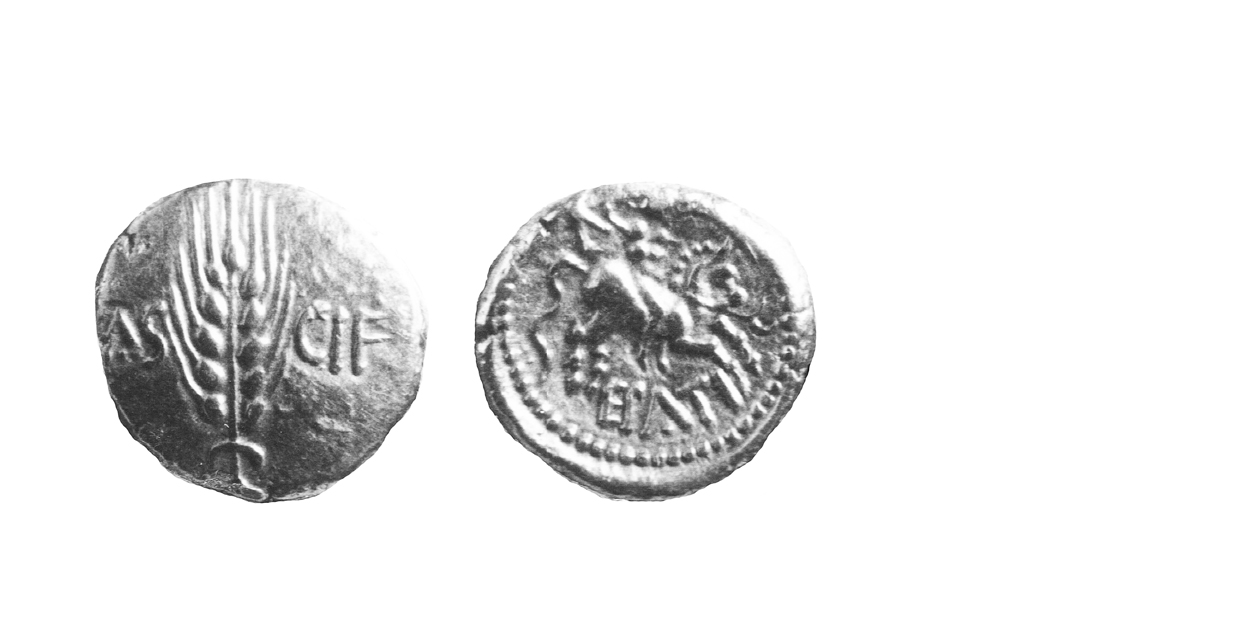
575 - 01 Epaticcus
35-43 A.D. Extremely Rare
Gold Stater 5.40 gms. 16 mm
Earliest Record: Camden, 1610 (Philemon Holland edition)
OBV: Corn ear
Identifying points:
1) corn ear has central stalk
2) TAS to left of ear
3) CIF to right of ear
REV: Celtic warrior on horse right
Identifying points:
1) warrior brandishes spear in right hand
2) warrior holds oval shield in left hand
3) EPATI below horse, C above, V behind
4) horse's tail may furnish the missing S
CLASSIFICATION: Atrebatic L
NOTES:
- Standard weight given
- Many in museums
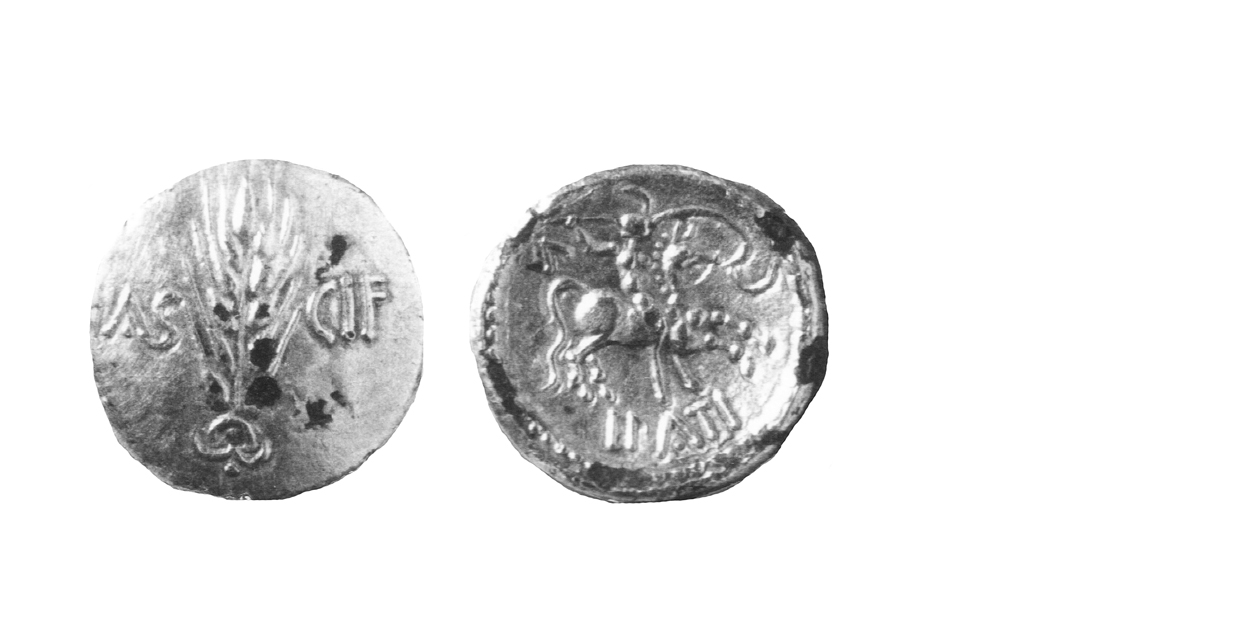
575 - 03 Epaticcus
35-43 A.D. Extremely Rare
Gold/Bronze Plated Stater 3.7 gms. 18 mm
Earliest Record: Van Arsdell, 1989
OBV: Corn ear
Identifying points:
1) as 575 - 01
REV: Celtic warrior on horse right
Identifying points:
1) as 575 - 01
CLASSIFICATION: Atrebatic L
NOTES:
- Struck from forger's dies
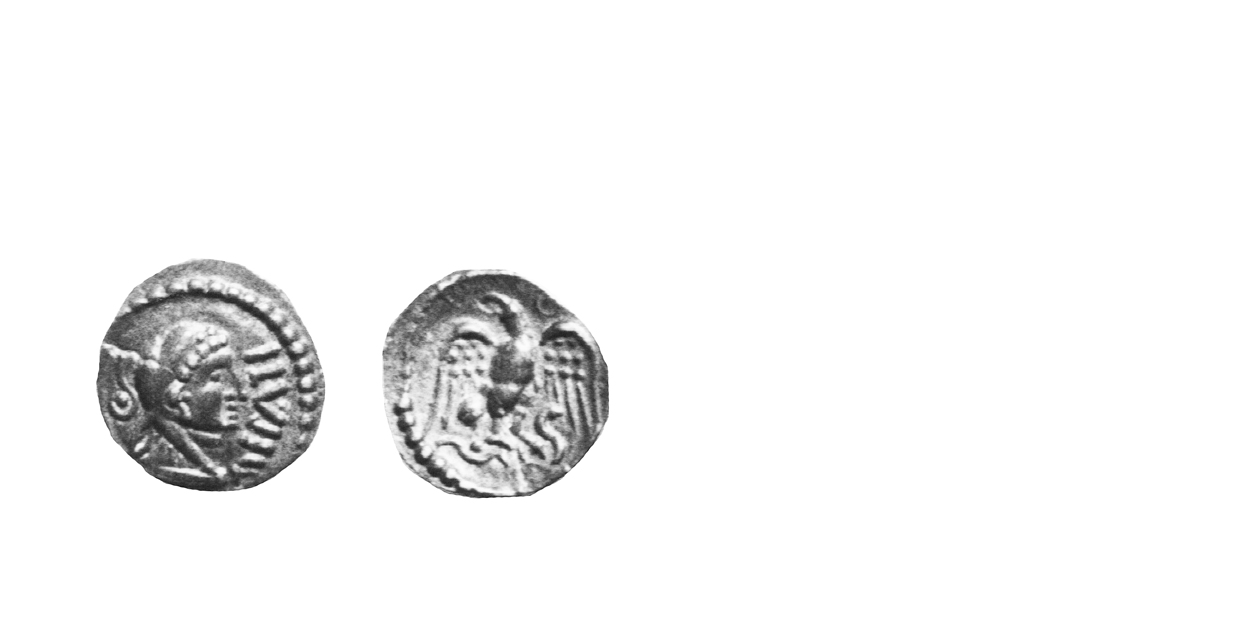
580 - 01 Epaticcus
35-43 A.D. Common
Silver Unit 1.3 gms. 12 mm
Earliest Record: Poste, 1853
OBV: Bust right
Identifying points:
1) bust wears lion's skin
2) EPATI in front of face
3) pellet border
REV: Eagle facing
Identifying points:
1) eagle's head turned to left
2) eagle has spread wings
3) pellet-in-ring motif above eagle
4) eagle holds serpent in claws
5) pellet border
CLASSIFICATION: Atrebatic L
NOTES:
- Many found at Wanborough
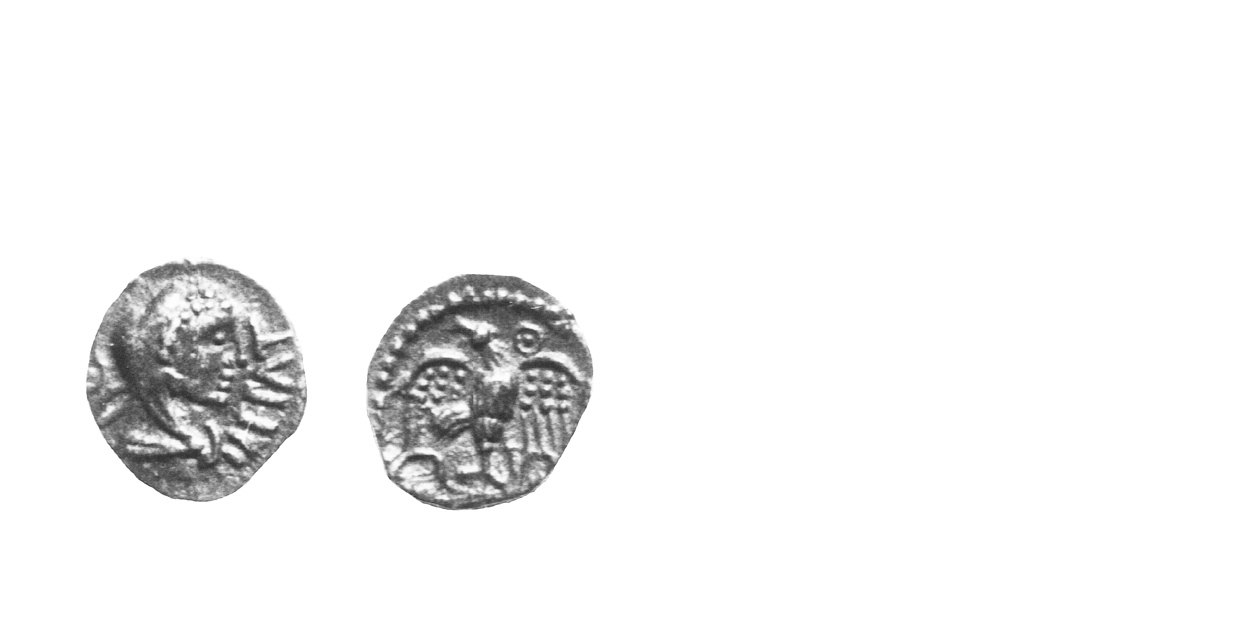
580 - 03 Epaticcus
35-43 A. D. Extremely Rare
Silver Unit 1.3 gms. 13 mm
Earliest Record: Van Arsdell, 1989
OBV: Bust right
Identifying points:
1) as 580 - 01, but EPAT
REV: Eagle facing
Identifying points:
1) as 580 - 01
CLASSIFICATION: Atrebatic L
NOTES:
- Many reportedly found at Wanborough, but Celtic Coin Index records indicate this type is rarer than originally thought
- Almost all the Wanborough finds must have been the 580-01 variety
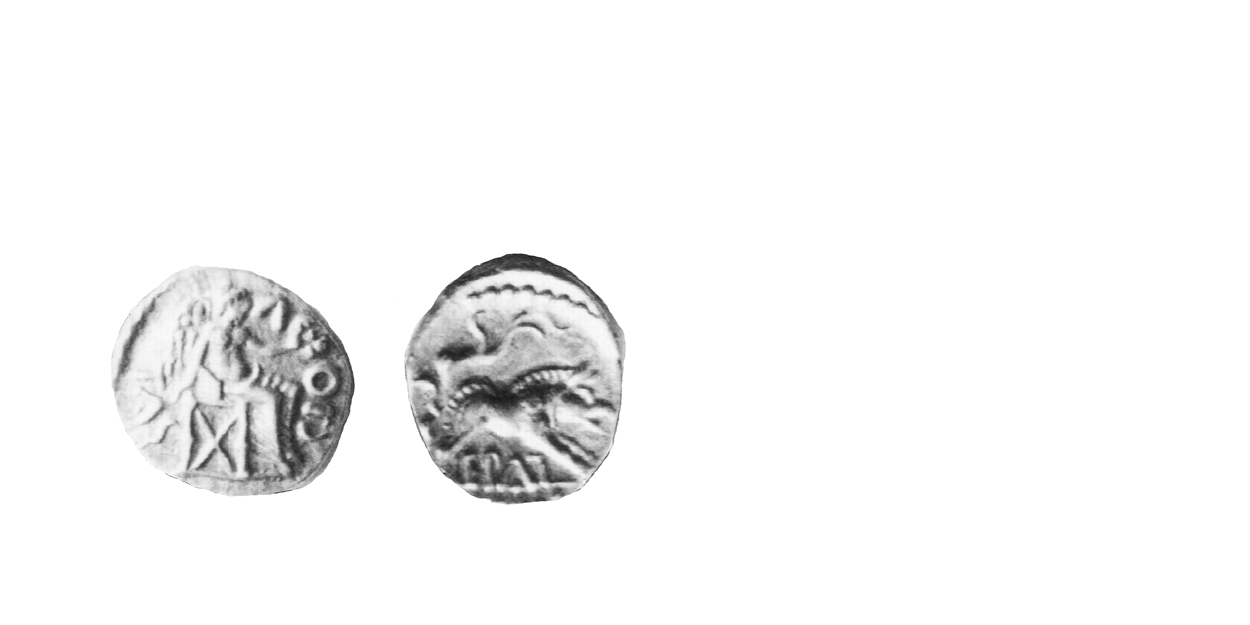
581 - 01 Epaticcus
35-43 A.D. Scarce
Silver Unit 1.3 gms. 12 mm
Earliest Record: Mack, 1964
OBV: Seated victory right
Identifying points:
1) victory sits on box with X
2) victory holds wreath
3) TASCIOV around victory
4) pellet border
REV: Boar right
Identifying points:
1) branch above boar
2) boar stands on exergual line
3) EPAT on exergual line
4) row of pellets below exergual line
5) pellet border
CLASSIFICATION: Atrebatic L
NOTES:
- Many found at Wanborough
- Obverse copied from a denarius of M. Volteius
- Reverse copied from a denarius of M. Porcius Cato or M. Porcius Cato Uticensis, or alternatively a jasper intaglio from Figsbury Rings
- Celtic Coin Index records indicate rarer than originally thought
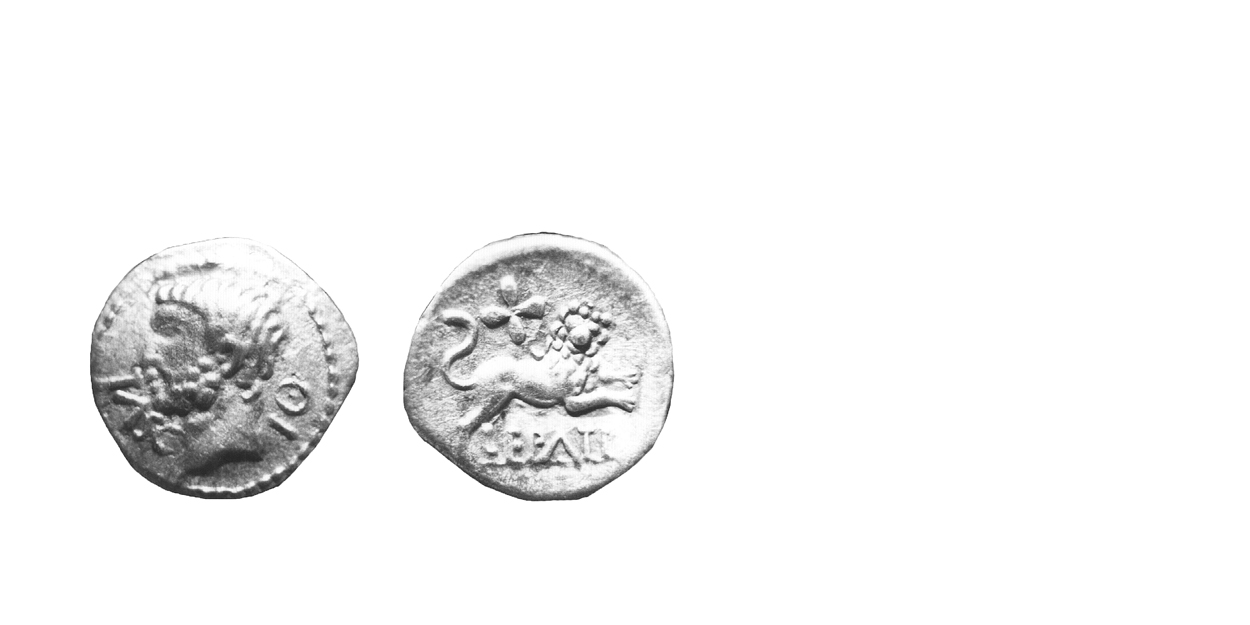
582 - 01 Epaticcus
35-43 A.D. Extremely Rare
Silver Unit 12 mm
Earliest Record: Van Arsdell, 1989
OBV: Bust left
Identifying points:
1) bust is bare-headed and bearded
2) TASC in front of face
3) IO behind head
4) pellet border
REV: Lion right
Identifying points:
1) EPATI below lion
2) flower with four petals above lion
3) lion turns head to face viewer
CLASSIFICATION: Atrebatic L
NOTES:
- Some found at Wanborough
- Trade survey in the 1980s indicated possibly commoner, but this has not proven to be the case
- Coin has not been authenticated via metallurgical analysis, but type appears authentic
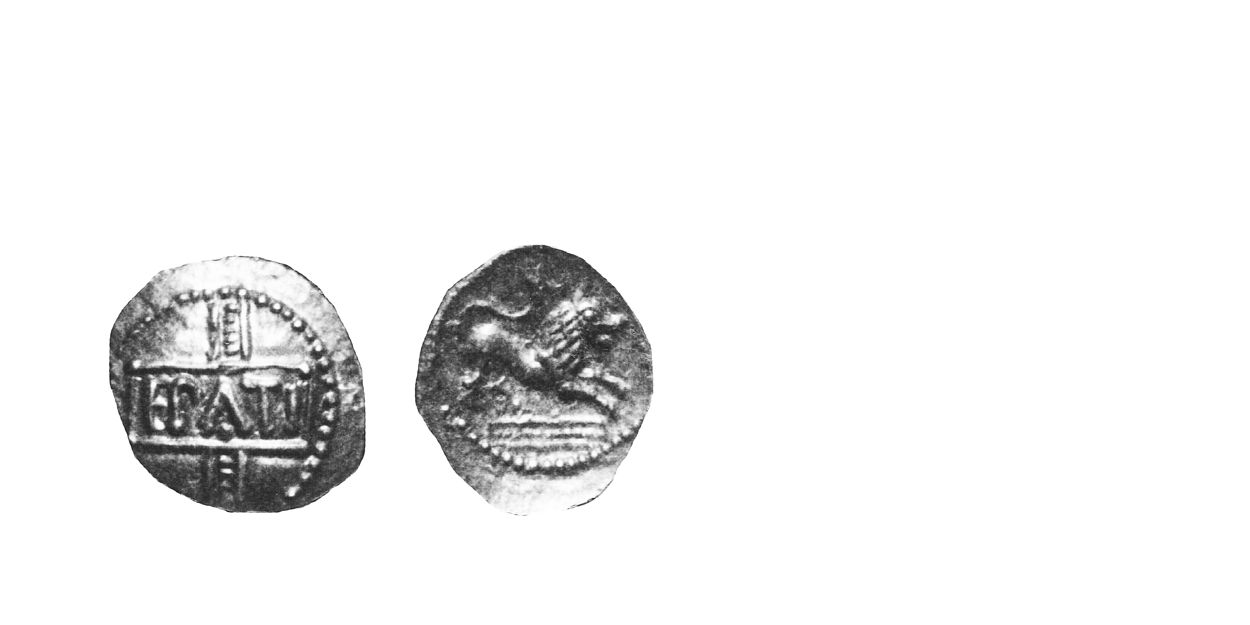
583 - 01 Epaticcus
35-43 A.D. Extremely Rare
Silver Unit 14 mm
Earliest Record: Van Arsdell, 1989
OBV: Inscription in tablet
Identifying points:
1) EPATI in box
2) two vertical lines extend above and below tablet
3) row of pellets between lines
REV: Lion right
Identifying points:
1) three exergual lines
CLASSIFICATION: Atrebatic L
NOTES:
- Some found at Wanborough
- Celtic Coin Index records indicate rarer than originally thought
- No weight data available
- Plate coin last seen December 1984, is no longer available for inspection
- Coin has not been authenticated via metallurgical analysis, but type appears genuine

585 - 01 Epaticcus
35-43 A.D. Scarce
Silver Minim 9 mm
Earliest Record: Mack, 1953
OBV: Inscription in pellet ring
Identifying points:
1) EPATI in centre
2) pellet-in-ring motif above and below EPATI
3) pellet border
REV: Boar's head right
Identifying points:
1) TA below boar's head
2) pellet border
CLASSIFICATION: Atrebatic L
NOTES:
- Some round at Wanborough.
- Celtic Coin Index records indicate the 1980s rarity estimate provided via trade survey was accurate
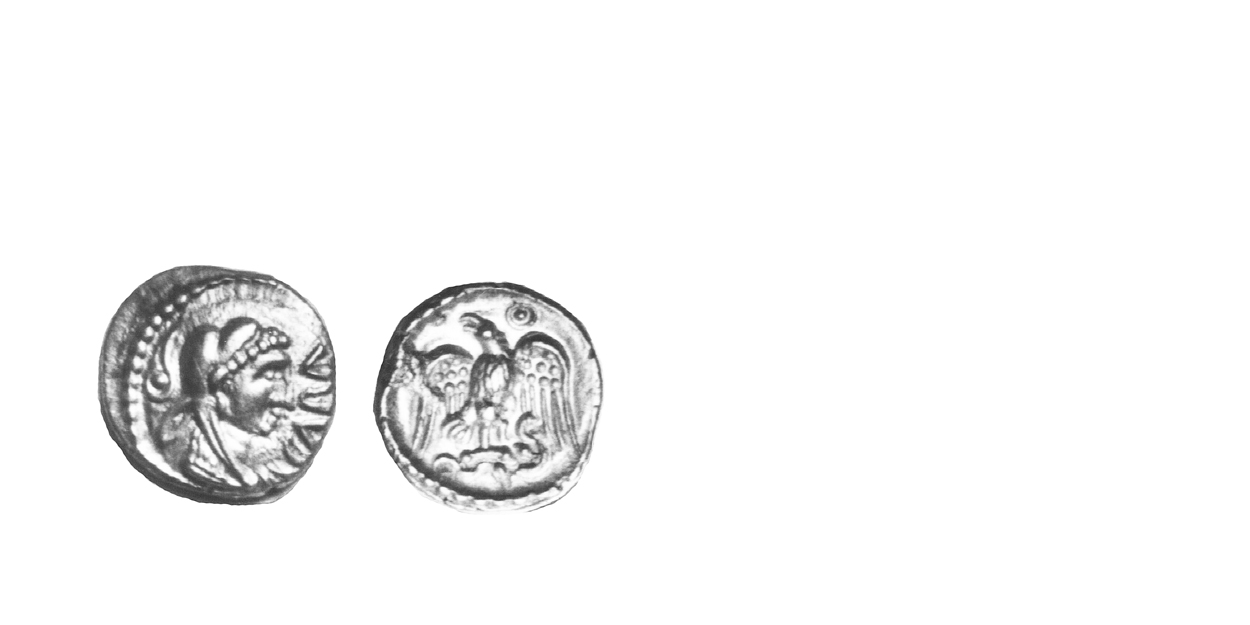
593 - 01 Caratacus
43-51 A.D. Rare
Silver Unit 1.3 gms. 12 mm
Earliest Record: Evans, 1890
OBV: Bust right
Identifying points:
1) bust wears lion's skin
2) CARA in front of face
3) pellet border
REV: Eagle facing
Identifying points:
1) eagle's head turned to left
2) eagle has spread wings
3) pellet-in-ring motif above eagle
4) eagle holds serpent in claws
5) pellet border
CLASSIFICATION: Atrebatic M
NOTES:
- Many found at Wanborough
- Type is direct descendant of 580 - 01
- Celtic Coin Index records indicate rarer than originally thought
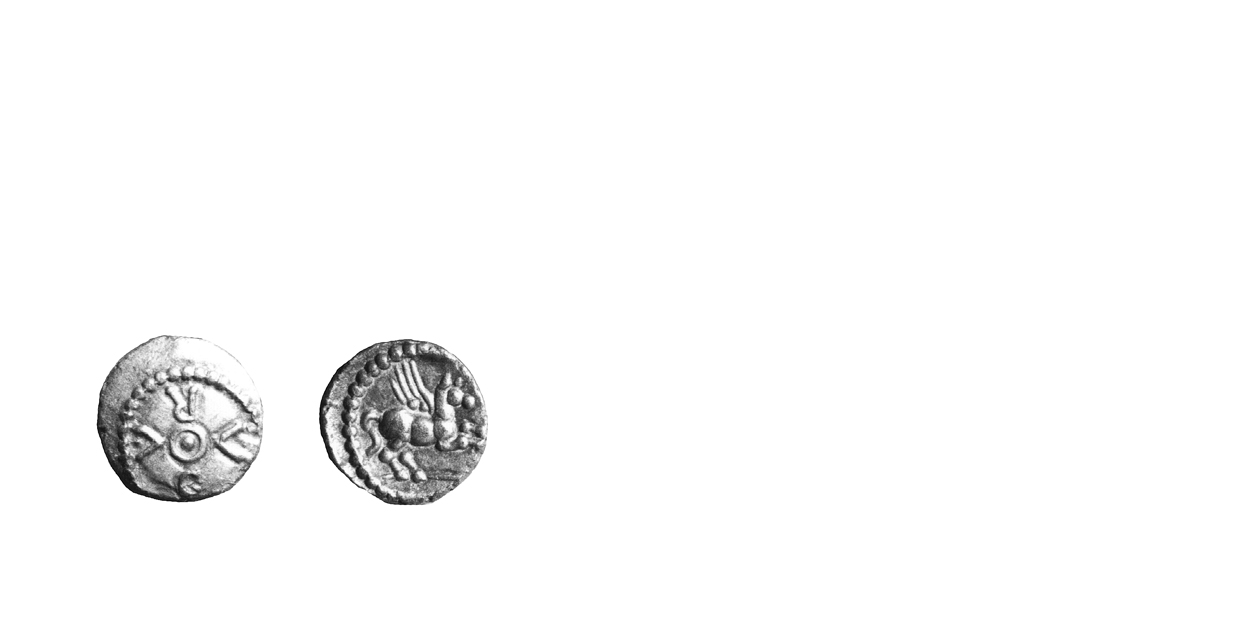
595 - 01 Caratacus
43-51 A.D. Very Rare
Silver Minim
Earliest Record: Van Arsdell, 1989
OBV: CARA around pellet-in-ring motif
Identifying points:
1) pellet-in-ring in centre
2) C A R A around pellet-in-ring motif
3) pellet border
REV: Pegasus right
Identifying points:
1) Pegasus stands on exergual line
2) pellet border
CLASSIFICATION: Atrebatic M
NOTES:
- The rarity of this type is almost impossible to judge
- Reports of many finds at Wanborough cannot be confirmed. The trade survey yielded ratings of Rare to Common
- Celtic Coin Index records indicate rarer than originally thought, but may reflect under-reporting
Coinage of the Atrebates, Regni & Belgae
The Atrebates, Regni and Belgae occupied the territory that is today Berkshire, Sussex and Hampshire. Whether three distinct political groups struck coins cannot be proven today, nor can separate territories be demonstrated. The Regni are virtually unknown to history until the Roman period, and the tribal area of the Belgae is a matter of controversy. Though Belgic immigration is mentioned by Caesar, he does not specifically say where they settled, and we only have the Roman name Venta Belgarum to suggest a location. The Atrebates, also mentioned by Caesar, had tribal members on both sides of the Channel.
Traditionally, the three tribes have been treated numismatically as one. Based on the current state of research, there is no reason to change this approach. Attempts have been made to identify a separate coinage for the Belgae. These have been largely, but not entirely, based on reports of new types of silver coins published in numismatic trade lists since 1994. The coins do not appear to form a coherent issue of a single issuing authority and questions exist regarding their precise status. These enigmatic coins demand careful analysis and reflection before they are accepted as evidence for a Belgic coinage. Certainly, after the Gallic War, only one coinage circulated in the territory. It may someday come to pass that coinages for the Belgae and Regni can be identified, but only after a rigorous analysis of the new types has been completed. Most of these are listed under "New Material". For the remainder of this discussion the three tribes will be referred to simply as the "Atrebates" for the sake of brevity.
Initially, the three tribes constituted one of the most advanced groups in Britain. They had trading contacts with Belgic Gaul in the late second and early first centuries B.C., and were one of the earliest to strike coins. The earliest stater, the INSULAR TYPE struck before the Gallic War, is derived from imported Gallo-Belgic C. The next coinage, the WESTERHAM TYPE, is now felt to be inspired by the Trinovantian/Catuvellaunian coinage of the same name, struck during the Gallic War. After the war, the tribal position changed dramatically, and the Atrebates may have fallen out of favour with the Romans. It is possible the cross-Channel trading rights were given to the Trinovantes/Catuvellauni instead. A loss of trading rights may have been the result of Commius' activities during the War.
Commius, at first a supporter of Caesar, became disillusioned with the Romans and went over to Vercingetorix. After the collapse of Celtic resistance at Alesia, he fled to join the British part of his tribe. Later, the Atrebates struck coins with his name, and possibly the acceptance of Commius in Britain was the reason they fell out of favour. The change in trading rights altered the relative fortunes of the two tribes forever. By the end of the millennium, the Trinovantes/Catuvellauni had economic influence throughout southern Britain and had begun to rival the Atrebates.
The Atrebates seized the opportunity of the Trinovantian/Catuvellaunian Interregnum to mount a military incursion into Kent under their leader, Eppillus. Eppillus struck a victory stater commemorating the initial success of the expedition. The incursion was cut short, however, by the elevation of Cunobeline to the Trinovantian/Catuvellaunian throne. He drove the Atrebates out of Kent and Eppillus promptly disappeared. He is replaced on the coins by Verica, a self-styled 'son of Commius'.
Sometime before the Claudian invasion, Verica was in turn overthrown. He probably was the historical Celtic leader 'Bericus' who appeared in Rome seeking aid from Claudius. Verica was replaced on the coins by Epaticcus, who styled himself a 'son of Tasciovanus'. Whether the family-tie was real is not so important, the result was the Atrebatic leadership was now held by a Trinovantian/Catuvellaunian sympathizer. Shortly before the Claudian invasion, Epaticcus was replaced by Caratacus, the famous leader of the British resistance against the Roman invaders. The Atrebatic coinage came to an end during the forties, as Caratacus fled westwards to lead the resistance amongst the tribes in Wales. One Atrebatic leader known to history, Cogidubnus, has not yet been identified on the coinage. It seems he was not elevated to leadership until the coinage had come to an end.
